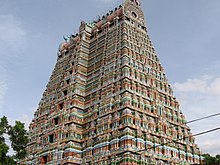Srirangam
| Srirangam ஸ்ரீரங்கம் |
||
|---|---|---|
|
|
||
| State : |
|
|
| State : | Tamil Nadu | |
| District : | Tiruchirappalli | |
| Location : | 10 ° 52 ' N , 78 ° 41' E | |
Srirangam ( Tamil : ஸ்ரீரங்கம் Srīraṅkam [ ˈsɾiːɾaŋɡʌm ]; more rarely Tiruvarangam or Thiruvarangam , Tamil: திருவரங்கம் Tiruvaraṅkam [ ˈtiɾɯʋaɾʌŋɡʌm ]) is a temple city in the southern Indian state of Tamil Nadu . It is located on a river island between the Kaveri River and its side arm, the Kollidam . Administratively, the place belongs to the city of Tiruchirappalli , the center of which is six kilometers south on the other side of the Kaveri River. The main attraction of Srirangam is the Sri Ranganathaswamy Temple, Tamil Nadu's most important Vishnu shrine and one of the most outstanding examples of the Dravida style of Hindu temple architecture .
location
Srirangam is located 320 kilometers southwest of Chennai (Madras) in the Tiruchirappalli district in central Tamil Nadu on a river island of the same name between Tamil Nadu's most important river, the Kaveri in the south and its side arm Kollidam in the north. The elongated island is almost 30 kilometers long and at its widest point about 2.5 kilometers wide. The branching of the Kaveri at Srirangam marks the beginning of the Kaveri Delta . The city of Srirangam is located in the central part of the island, the rest of the island is used for agriculture and is characterized by fields and palm groves.
Administratively, Srirangam is part of the city of Tiruchirappalli , the city center of which is on the southern side of the Kaveri. It is around four kilometers from the Sri Ranganathaswamy Temple in Srirangam to the Rock Fort in the center of the old town of Tiruchirappalli, and the distance to Tiruchirappalli Junction train station in the new town ( cantonment ) is around nine kilometers. Two road bridges and one railway bridge each lead over Kaveri and Kollidam. There are numerous bus connections to the center of Tiruchirappalli. The National Highway 45 (Grand Southern Trunk Road), the most important north-south route in Tamil Nadu, runs east of Srirangam. Srirangam also has its own train station on the main line from Tiruchirappalli to Chennai.
Sri Ranganathaswamy Temple
The main attraction of Srirangam is the Sri Ranganathaswamy Temple , which is also one of the most outstanding examples of the South Indian Dravida style of Hindu temple architecture . As is characteristic of this architectural style, the Sri Ranganathaswamy Temple has a rectangular floor plan and is built according to geometric principles. The main temple in the center of the extensive complex is enclosed by seven concentric wall rings with 21 gopurams (gate towers). The entire complex covers an area of 960 × 825 meters. The actual temple area is located in the area between the four innermost wall rings. Here you will find an angled ensemble of various shrines, pillared halls and corridors. The outer areas of the temple complex form a district mainly inhabited by Brahmins with streets, houses and shops. As a result, Srirangam represents a "temple city" in the truest sense of the word and can be considered an ideal example of the Dravida temple style.
The oldest parts of the Sri Ranganathaswamy Temple date from the reign of the Chola King Parantaka I (907–955). The temple was gradually expanded under the subsequent ruling dynasties of the Hoysala and Pandya in the 13th century, the Vijayanagar kings from the 14th century and the Nayaks from the 16th century. The Rajagopuram (main gopuram) at the south entrance of the temple complex, at 72 meters the largest and most imposing of the temple towers, was not even completed until 1987.
The Sri Ranganathaswamy Temple is dedicated to the deity Ranganatha , a form of Vishnu . Srirangam is thus a center of Vishnuism in the otherwise strongly Shivaitic Tamil Nadu. The Sri Ranganathaswamy Temple is the largest Vishnu shrine in the state and is considered the most important of the 108 Divya Desams (holy places of Tamil Vishnuism). Hence, it is an important pilgrimage destination that attracts believers from different parts of Tamil Nadu. In addition, there is traditionally a strong presence of Vishnuit brahmin scholarship in Srirangam . In the 12th century the famous Vishnuit philosopher Ramanuja worked in Srirangam. The "southern school" ( Tenkalai ), one of two subdivisions of the Srivaishnava direction of Vishnuism widespread in southern India , has its center in Srirangam, while the "northern school" is located in Kanchipuram . The Sri Ranganathaswamy Temple of Srirangam is one of three temples on the Kaveri river islands that are dedicated to Vishnu in his form as Ranganatha. The other two are in Srirangapattana and the Shivanasamudra Falls on the upper reaches of the Kaveri in Karnataka State .
Sri Jambukeshwara Temple
The Sri Jambukeshwara Temple on the eastern edge of Srirangam is largely overshadowed by the more well-known Sri Ranganathaswamy Temple, but is also of great religious and architectural importance. It is consecrated to the god Shiva in his manifestation as Jambukeshwara. Here Shiva is supposed to manifest in the element water. This makes the Sri Jambukeshwara Temple one of the "five-element temples" ( Pancha Bhuta Sthalangal ), in which Shiva is worshiped as a manifestation of the elements fire, earth, water, wind and ether.
The sanctuary is mentioned by the Nayanmar (Shivaite hymn poets) between the 7th and 9th centuries . The oldest components of the temple can be dated to the 10th century. Like the Sri Ranganathaswamy Temple, the Sri Jambukeshwara Temple was expanded under those of the Pandya, Hoysala, Vijayanagar and Nayak periods. Today it comprises a complex with five concentric wall rings and seven gopurams.
literature
- VN Hari Rao: The Srirangam Temple. Art and architecture. Tirupati 1967.





